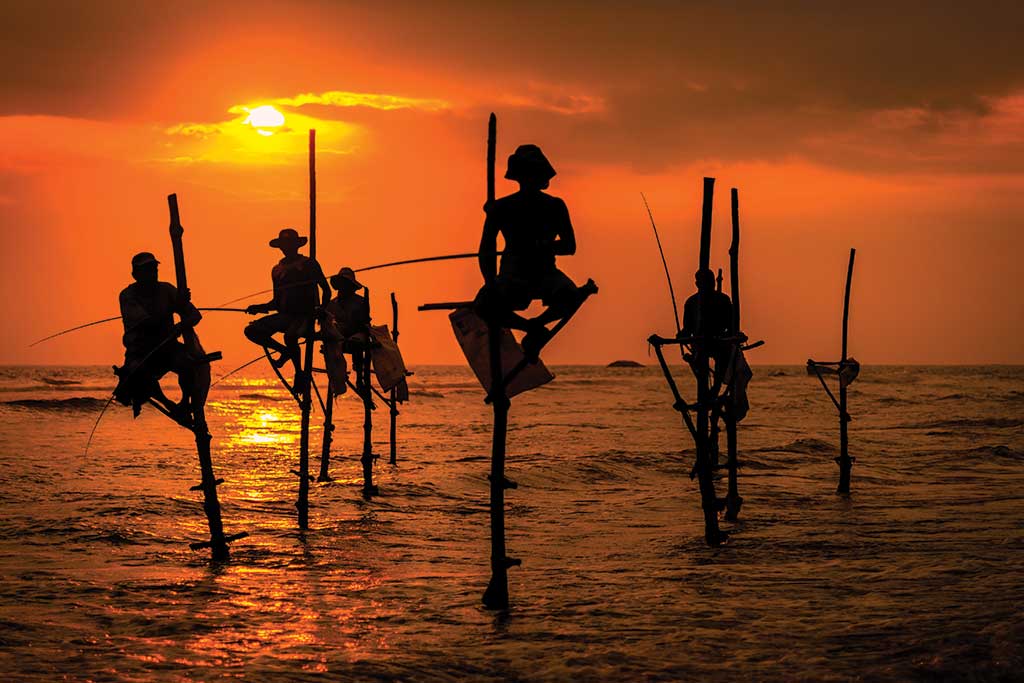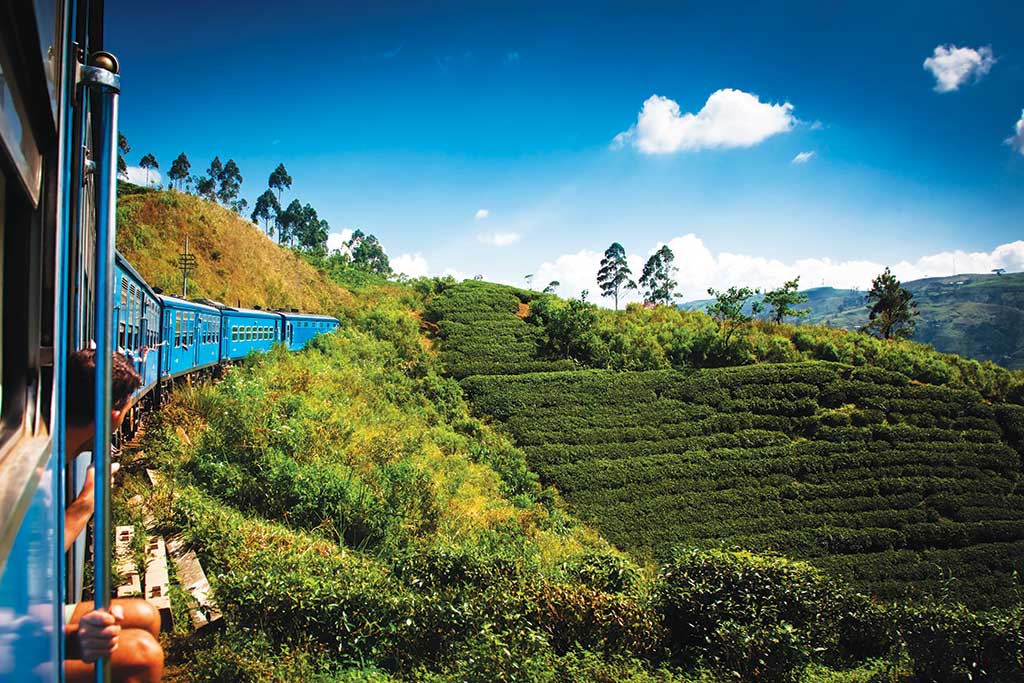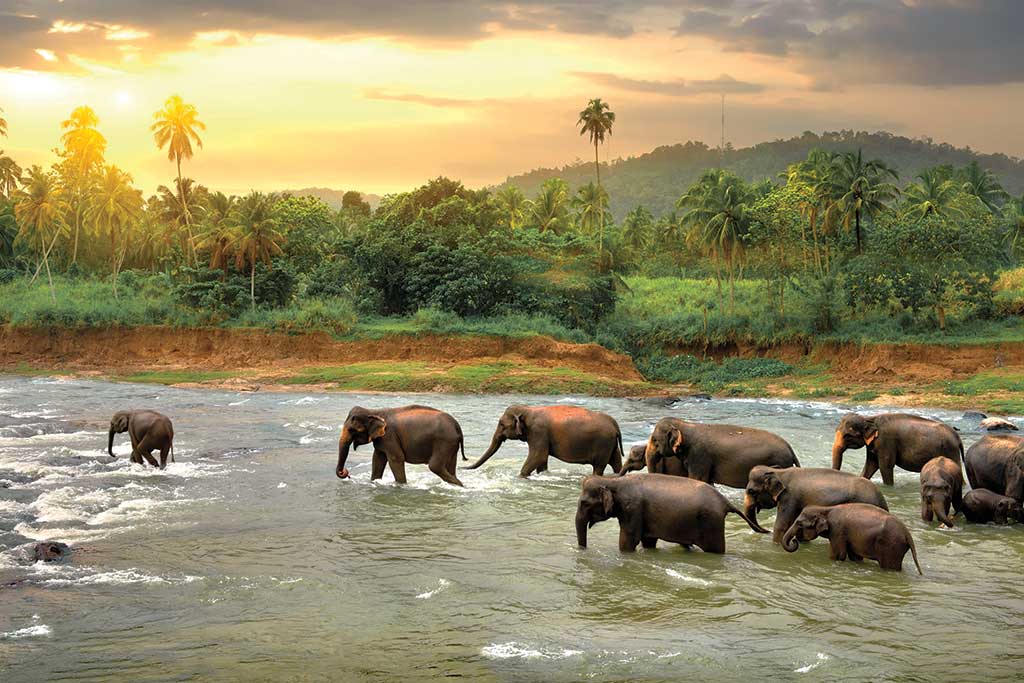Sri Lanka offers broad sandy beaches, astounding cultural and historic sites, stunning wildlife refuges, and misty hilltop tea plantations, all within relatively short and smooth-paved driving distances from each other.
Just over 30 miles from the southern tip of India, across the narrow Palk Strait, lies the island nation of Sri Lanka. This small country is similar in size to Ireland, but with delightfully dissimilar weather (temperatures generally between 75 and 80 Fahrenheit year round). Formerly known as Ceylon, the island offers broad sandy beaches, astounding cultural and historic sites, stunning wildlife refuges, and misty hilltop tea plantations, all within relatively short and smooth-paved driving distances from each other.

Temple in Dambulla Sri Lanka
With its winning combination of ease and exoticism, one might assume you’d find Sri Lanka on any avid traveler’s must-go list, but this is a country that for a quarter century (beginning in 1983) suffered the ravages of a civil war between the island’s two largest ethnic groups, the majority Sinhalese and the Tamils, who represent 15% of the population.
Accusing the national government of discrimination and demanding the establishment of an independent country, the Tamils’ tenacious guerilla-style attacks and bombings kept the nation perpetually on edge.
By the war’s final battles and ultimate ceasefire in 2009, the Unit- ed Nations estimated that nearly 100,000 Sri Lankans had been killed in the conflict.
During its decades of unrest, Sri Lanka dropped off most foreign travelers’ holiday itineraries, but over the past seven years, a more stable and inclusive national government has begun to steer a new course. From war’s end through 2016, the country’s economy has thrived and the annual number of foreign visitors has quadrupled.
Nuwan Mahawattage, the vice president of the Sri Lanka Institute of Tourist Guide Lecturers says, “It’s as if the people had to keep all of their energy and entrepreneurialism bottled up for years, and then, boom, things have moved very quickly.”
Roads and infrastructure have been significantly upgraded, and the government has invested heavily in tourism, which has become a major economic driver, along with the export of textiles, rice, coconuts, and gem- stones. And the Sri Lankan people have embraced the opportunity to engage with a stream of visitors that had all but dried up for three decades.
Yet, while English is commonly spoken in Sri Lanka’s major cities and those areas typically visited by foreign travelers, the country still hasn’t registered on most Americans’ destination radars.
In 2016, the US ranked just ninth among countries whose citizens traveled to Sri Lanka—only about 54,000 Americans visited. At the same time, the US was the world’s number one source of tourists for neighboring India (more than 1.2 million Americans visited last year). There’s a bit of irony to that.
With great pride and a pinch of snark, Mahawattage and other native travel professionals describe Sri Lanka as “the cleaner, calmer India.”
That’s a reasonable perception. In the months since I returned from a regrettably short trip to Sri Lanka, I’ve been describing the country as “India with training wheels.”
Truth be told, having spent extraordinary and enlightening time in both countries, I’ll confess that I’m more likely to return to Sri Lanka.
With its 26 languages, tens of thousands of Hindu deities, teeming cities, chaotic roadways, visual overload, and whatever one calls the olfactory-version of crowd noise, India was thrilling, but often draining.
Friends of mine who know I travel frequently often ask if I’ve “done” this country or that. India? You don’t do India. India does you.

Traditional Fishermen at Sunset in Sri Lanka
Sri Lanka, on the other hand, felt remarkably doable. It’s a place where you can have meaningful encounters with different cultures and ways of life but still come home feeling like you’ve had a vacation.
My trip, with a small group of gay friends, was organized by top-notch tour company Aitken Spence, which made our experience special from almost the moment we stepped off of the plane in Sri Lanka’s capital city, Colombo.
A quintet of traditional Ved dancers escorted us from the baggage claim to our motor coach, delighting everyone who happened to be in the parking lot that morning with the twirls, flips, and rat-a-tat drumbeats of a Buddhist ceremonial performance.
The five young men wore metal-ornamented headgear that jangled with their motions, white skirt-like dhotis, and elaborately beaded netting over bare, toned torsos.
This eye candy hailed from a town called Kandy, home of a major Buddhist worship site we would visit on the following day’s itinerary, and I was pleased to learn that their routine was not boysploitation for visiting gay Westerners, but a form of dance traditionally performed only by men.
The willingness of Sri Lanka-based Aitken Spence to bring gay tour groups to their country, and the company’s confidence that LGBT guests will be treated with the same warmth and respect Sri Lankans extend to any visitor (borne out by my experience), is a sign of slow attitudinal shifts toward the LGBT community throughout this primarily Buddhist country.
Same-sex relationships remain technically illegal, but there is little enforcement of the law in Colombo. The government has not interfered with small annual pride events, including film festivals and drag fashion shows that have taken place in the capitol for over a decade.
While not gay-specific, Sri Lanka even has its own highly informative national print and online edition of Time Out magazine (www.timeout.com/sri-lanka), with the same urbane, contemporary attitude that brand exudes worldwide.
That said, there are no permanent businesses catering to the community yet, and as in much of South Asia, including most of India, multi-generational family village life keeps many gays and lesbians hiding in the closet.
Since 2004, Equal Ground, a national advocacy group, has been increasingly active, offering much-needed anonymous phone counseling and online social networks, as well as organizing pride events and publishing the country’s only LGBT magazine, Equality.
Equal Ground has also had important initial success in lobbying. In 2014, in response to the group’s appeal to the United Nations Human Rights Committee, the Sri Lankan government acknowledged for the first time that the non-discrimination clause of the national constitution “protects persons from…stigmatization on the basis of sexual orientation and gender identities,” opening avenues for further engagement of the gay community with policy makers.

Train from Nuwara Eliya to Kandy among Tea Plantations
In Colombo, one can pay homage to architect Geoffry Bawa (1919- 2003), perhaps the world’s best-known Sri Lankan and, as it happens, a gay man.
Bawa whose part Sinhalese, part European lineage speaks to Sri Lanka’s pre 1948 history as a colony of Dutch and English empires, is known as the father of Tropical Modernism. His buildings combine stark- white structures and regimented vertical columns reminiscent of Le Corbusier, with rough-hewn stone, wood, and other materials native to Sri Lanka, Malaysia, Japan, and the other countries where he worked.
They are also exemplars of indoor-outdoor living spaces, with rooms that spill into courtyards, walls of plate glass, and often ornate plantings and gardens created in collaboration with his brother, Bevis, an esteemed landscape architect who was also gay.
Visitors to Colombo can tour Bawa’s one-time home and studio on 33rd Lane, created over the course of ten years (1958-68) through the gradual acquisition and integration of four adjacent townhouses.
The evolution and expansion of Bawa’s style can also be seen in Colombo, at the Sri Lankan Parliament complex (1977-80), an elegant series of low-slung pavilions with shimmering copper roofs set on an island in a man-made lake.
Once familiarized with Bawa’s work, travelers will notice his projects, and his ubiquitous influence, throughout the country, in hotels, colleges and private homes.
Our first dinner in Sri Lanka took advantage of the country’s 360-degree coastline. Lagoon, an exceptional seafood restaurant on the grounds of the sleek, contemporary Cinnamon Grand Hotel in Colombo, was one of the trip’s culinary highlights. The center-piece of this handsome room of modern, polished wood is an enormous, fishmarket-style counter, heaped with icy piles of lobsters, crabs, up to a dozen varieties of whole fish, octopus, squid, and bushels of shellfish.


